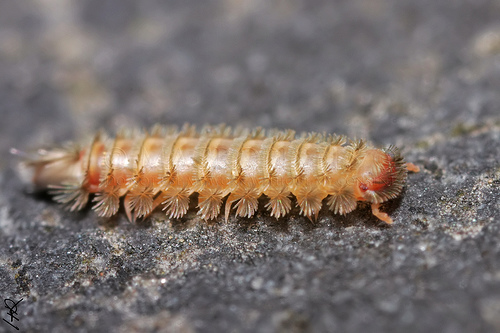Polyxenida
Not to be confused with Polyxenidas.
Polyxenida is an order of millipedes readily distinguished by a unique body plan consisting of a soft, non-calcified body ornamented with tufts of bristles – traits that have inspired the common names "bristly millipedes" or "pincushion millipedes". There are at least 86 species in four families worldwide, and are the only living members of the subclass Penicillata.
Description
Polyxenida differ from other millipedes in having a soft, non-calcified exoskeleton, unique tufts of bristles or setae, fewer legs (no more than 17 pairs), and an absence of copulatory appendages in males. Individuals are small, not exceeding 7 millimeters (0.28 inches).
Defense
Bristly millipedes lack the chemical defenses and hard exoskeleton of other millipedes, and instead employ a unique defense mechanism: the distinctive barbed bristles can easily detach and become entangled in the limbs and mouth-parts of predatory insects, effectively immobilizing them.
Reproduction
Male Polyxenidans lack the modified sperm-transferring appendages (gonopods) found in most other millipede groups. As a result, sperm transfer is indirect: males deposit a spermatophore that is subsequently picked up by females.
Many species reproduce asexually by way of parthenogenesis, wherein females lay eggs without mating and males are absent or rare.
Classification
Phryssonotus brevicapensis (Synxenidae), a species from South Africa described in 2011
Polyxenida is the only living order of the subclass Penicillata, the basal subclass of millipedes. Penicillata is the sister group of all other living millipedes: the subclasses Pentazonia and Helminthomorpha).
In 2003 the Polyxenida contained 159 valid species and/or subspecies, although at least eight new species have been described since 2010.
Superfamily Polyxenoidea Lucas, 1840
Hypogexenidae Schubart, 1947
Lophoproctidae Silvestri, 1897
Polyxenidae Lucas, 1840
Superfamily Synxenoidea Silvestri, 1923
Synxenidae Silvestri, 1923
^ a b Nguyen Duy - Jacquemin, Monique; Uys, Charmaine; Geoffroy, Jean-Jacques (2011). "Two remarkable new species of Penicillata (Diplopoda, Polyxenida) from Table Mountain National Park (Cape Town, South Africa)" (PDF). ZooKeys. 156 (0): 85–103. doi:10.3897/zookeys.156.2211. PMC 3253573free to read. PMID 22303097.
^ Sierwald, Petra; Bond, Jason E. (2007). "Current Status of the Myriapod Class Diplopoda (Millipedes): Taxonomic Diversity and Phylogeny". Annual Review of Entomology. 52 (1): 401–420. doi:10.1146/annurev.ento.52.111805.090210. PMID 17163800.
^ Shear, W (2011). "Class Diplopoda de Blainville in Gervais, 1844. In: Zhang, Z.-Q.(ed.) Animal biodiversity : an outline of higher-level classification and survey of taxonomic richness" (PDF). Zootaxa. 3148: 159–164.
^ Nguyen Duy-Jacquemin, M.; J.-J. Geoffroy (2003). "A revised comprehensive checklist, relational database, and taxonomic system of reference for the bristly millipedes of the world (Diplopoda, Polyxenida)". African Invertebrates. 44 (1): 89–101.
^ Short, Megan; Huynh, Cuong (2011). "The genus Unixenus Jones, 1944 (Diplopoda, Penicillata, Polyxenida) in Australia". ZooKeys. 156: 105–122. doi:10.3897/zookeys.156.2168.
^ Short, Megan; Huynh, Cuong (2013). "Four new species of Unixenus Jones, 1944 (Diplopoda, Penicillata, Polyxenida) from Australia". ZooKeys. 278: 75–90. doi:10.3897/zookeys.278.4765.
Fossil history
The earliest representatives of Polyxenida are found in Lebanese amber from the Early Cretaceous period.
Some authors place the extinct orders Arthropleurida and Eoarthropleurida (each represented by a single genus) within the Penicillata as a sister group to Polyxenida.
source - Wikipedia
if u like the post please like and shear



0 comments